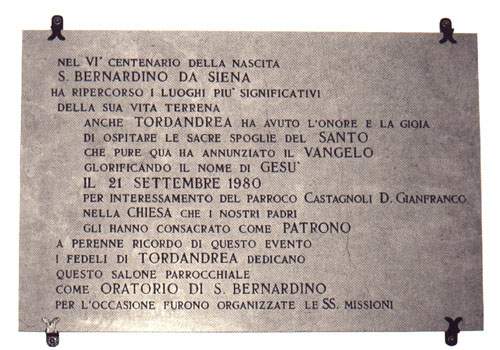Church and parish of St. Bernardino
(photograph)"Extra Castrum"
Between 1530 and 1573 a new parish church, dedicated to St. Bernardino, was build outside the castle of the Torre d'Andrea and near it: the ancient church that existed inside the castle was by that time too little for the growth of the number of the population of the Baglioni's marquisate. In spite of the times still problematic and uncertain, life also in our countries tended to "go outside". People gained again the country, more secure than in the past. Castle walls were only a decorative element of the ancient medieval town. By then dangers - incursions and wars, anyhow more rare - did not stop in front of the walls. Also the Church seized the change and opened itself on the outside. To the above mentioned mons. Camaiani, the church of Sancti Bernardini extra castrum, which he visited July, 20, 1573, appeared as well kept. The church had two altars; near the high one there was a door that the visitor order to close. He found also some rooms, residence of the chaplain, built above the church and he prohibited to use. From that time the parishioners took care of their parish priest. The visitor condemned the fact that the chaplain was ad libitum, i.e. elected directly by the parishioners to take care of the parish and, for that reason, he was transferable whenever they wanted. For the fact that the church did not have fixed incomes parishioners give a salary to the priest. During that years the priest was Don Francesco di Antonio della Bastia. The apostolic visitor realised that he did not kwon Latin language, nevertheless he had a n instruction and he was able to read. Mons. Camaiani ordered him to get a Catechism in vulgar tongue, to study it and to be examined about it. During mons.Camaiani's visit the church did not have a font. Also in 1586, when mons.Brugnatelli, Assisi's bishop visit it, there wasn't any font. Up to that time, in fact, babies of Tordandrea were baptized in Assisi or in Bastia. But in consequence of the fact that the population of the parish had grown (the families passed from 54 in 1573 to 96), mons.Brugnatelli ordered to build a font in the church of St. Bernardino. The presence of this font near the door of the church, in the right, is mentioned in 1594. In that year the church hasn't got any bell and for this reason the priest used the one near the door of the castle. In the church there aren't any graves and dead persons were taken in the church of S. Maria degli Angeli. The priest, again ad natum ed amovibilis, is at least since 1586, don Tiferno Sereni from Collemancio, who remained with this task untill 1599 and his presence is attested also in 1605: this is a sign of the approval of the people. In 1600 the church still lacks bell and bell-tower; also the confessional was absent: Assisi's bishop, mons.Crescenzi, visiting the church, ordered the priest don Marcantonio Cioli to build it. When Tordandrea passed again under the municipality of Assisi, in 1614, a problem rose for the parish of St. Bernardino: the payment of the land tax for the priest's maintenance. Assisi's citizens who owned lands in Tordandrea's territory didn't want to pay that tax. After a quarrel with Tordadrea's parishioners they were condemned to pay the land tax, even if they didn't reside in Tordandrea. In the early eighteenth century parish church had three altars: the high one consecrated to St. Bernardino and the others to St. Joseph and to St. Rosary. To the priest don Bartolomeo Moscatelli all appeared well maintained but the church was uncomfortable and narrow. In September 20, 1794 don Antonio Biondi became priest of Tordandrea and in October 19, 1797 he received mons. Francesco Maria Giampè, Assisi's bishop, in pastoral visit. After Napoleonic domination October 21, 1818 bishop Giampè found don Antonio Biondi as perpetual priest of Tordandrea. Parish was still poor because its only incomes were land taxes Children were not much learned in catechism, also in consequence of the fact that their parents didn't send them to the parish. There weren't any blasphemer, nor shameful practices, nor divorces in the parish, except in a family. Only two were the persons which received the sacraments only the Easter period. In 1832 Tordandrea, like other town of Umbrian valley, was struck by a terrible earthquake which destroyed the church and the parish house, burying the priest don Antonio Biondi under the debris. During the reconstruction and restoration of the collapsed church it was found a picture of the Crucifix, which was retained and exposed to the believers worship. In the middle of nineteenth century the incomes of the parish increased. In 1853 the parish owned three houses, a stable and ten pieces of ground. Some of those estates were sold to pay the reconstruction of the church, destroyed by the earthquake of 1832. Finally in 1896 a resident parish priest was designated: don Ettore Micheletti. He instituted a "Cassa Agricola". In 1919 don Vincenzo Piazza succeeded to him. Don Piazza renewed the tradition of the priest chosen by the population and designated by the bishop. In 1922 a new sacristy was built. In the meanwhile the church was modified and recently it had been plastered and radically renewed. The inauguration of the temple took place on May 20, 1994, St. Bernardino's Day, in the presence of mons. Sergio Goretti, diocesan bishop.

Tordandrea, parish hall
Memorial tablet for St.Bernardino's birth VI Centennial